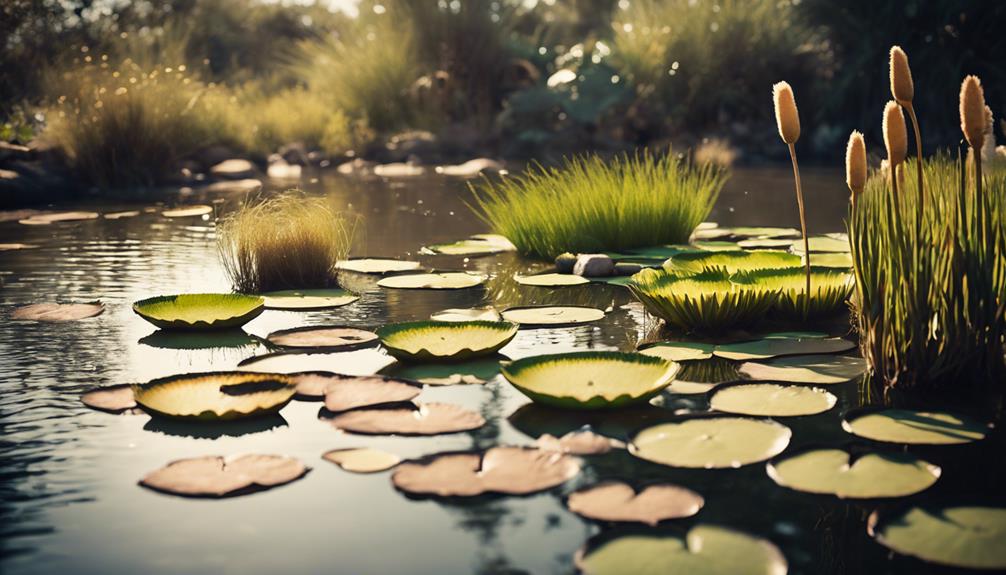You can create a thriving aquatic garden even in areas with low rainfall or water restrictions by incorporating drought-tolerant aquatic plants that require minimal maintenance and care. Consider water lilies, cattails, and hornwort, which thrive in low-water conditions and provide ecological benefits. Succulents, like azolla and duckweed, absorb excess nutrients and grow fast with low maintenance. If you're looking for more options, floating plants like water lettuce and water hyacinth, or succulent plants for water gardens can also provide a stunning and low-maintenance solution. Discover how these plants can help you achieve a beautiful and sustainable aquatic garden.
Table of Contents
Key Takeaways
- Drought-tolerant aquatic plants like water lilies, cattails, and hornwort require minimal maintenance and watering, making them perfect for low-maintenance gardens.
- Floating plants like water lettuce and duckweed absorb excess nutrients, provide habitat, and grow fast with low maintenance, ideal for busy gardeners.
- Succulents in water gardens absorb excess nutrients, reduce algae growth, and store water, making them a great choice for low-maintenance gardens.
- Low-water aquatic plants like waterlily, cattail, and hornwort can thrive in areas with infrequent rainfall or water restrictions, requiring minimal care.
- Drought-tolerant aquatic species like Texas Star Hibiscus, Dwarf Papyrus, and Horsetail Rush tolerate full sun to partial shade with minimal upkeep, perfect for water-scarce environments.
Water-Wise Plants for Ponds
When designing a water-wise pond, you'll want to incorporate plants that not only thrive in low-water conditions but also provide ecological benefits, such as water lilies and cattails, which require minimal maintenance and watering.
These drought-tolerant plants are perfect for ponds with limited water supply, as they can survive with minimal watering. Additionally, they provide shade, reduce evaporation, and create a habitat for aquatic animals.
Another great option is hornwort, a low-growing, fast-spreading aquatic plant that helps to oxygenate pond water and reduce algae growth.
This makes it an ideal choice for water-wise ponds, as it promotes healthy water conditions while requiring minimal care.
By incorporating these plants into your pond design, you'll create a thriving ecosystem that not only looks beautiful but also supports local wildlife.
With these drought-tolerant plants, you can enjoy a low-maintenance pond that's perfect for your water-conscious garden.
Drought-Tolerant Floating Plants
By incorporating drought-tolerant floating plants into your pond design, you'll not only conserve water but also create a thriving ecosystem that supports aquatic life and maintains water quality. These plants are perfect for low-maintenance gardens, requiring only 1-2 inches of water per week. Some popular options include water lettuce, water hyacinth, and water wisteria, which can provide shade and help reduce algae growth.
Here are some benefits and characteristics of drought-tolerant floating plants:
| Plant | Benefits | Characteristics |
|---|---|---|
| Water Lettuce | Absorbs excess nutrients, provides habitat | Fast-growing, low-maintenance |
| Water Hyacinth | Reduces algae growth, provides shade | Fast-growing, invasive in some regions |
| Water Wisteria | Provides shade, reduces algae growth | Fast-growing, low-maintenance |
| Duckweed | Absorbs excess nutrients, provides habitat | Fast-growing, low-maintenance |
| Azolla | Absorbs excess nutrients, provides habitat | Fast-growing, low-maintenance |
Remember to check local regulations before introducing any new plants to your garden, as some drought-tolerant floating plants can be invasive in certain regions. By choosing the right plants for your pond, you'll create a thriving ecosystem that requires minimal maintenance and care.
Low-Maintenance Aquatic Grasses
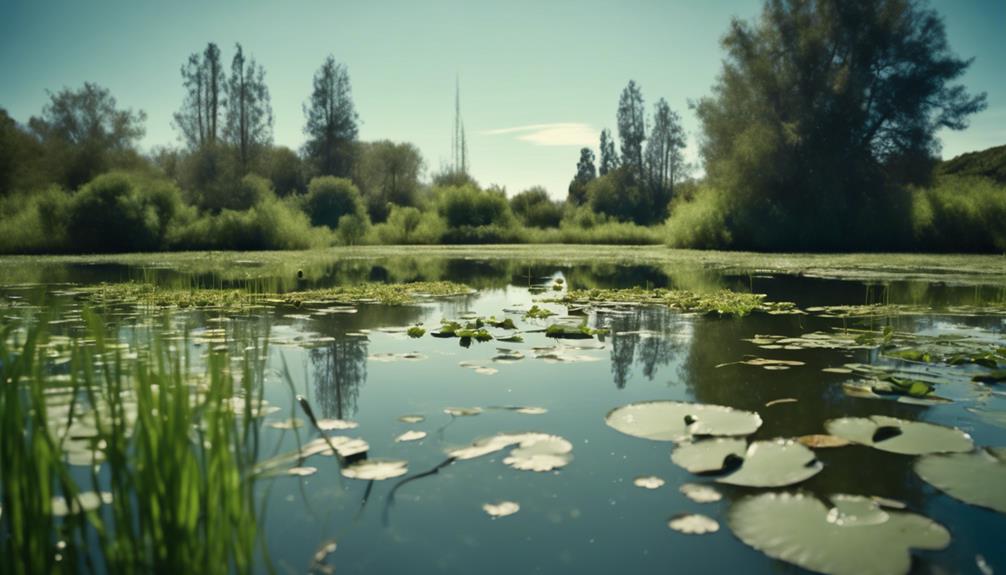
As you explore the world of low-maintenance aquatic grasses, you'll find that certain species stand out for their ease of care and versatility.
You'll want to look into grasses like Soft Stem Bulrush, Dwarf Hairgrass, and Slender Twigs, which offer unique benefits and requirements for your aquarium or pond.
Soft Stem Bulrush Care
Soft Stem Bulrush, a low-maintenance aquatic grass, requires minimal upkeep to thrive in its preferred environment. This hardy plant can tolerate a wide range of water depths, from 1-6 feet, and grows best in full sun to part shade.
Soft Stem Bulrush can survive temperatures ranging from 35°F to 85°F (2°C to 30°C).
This plant has a moderate to fast growth rate, reaching heights of 3-6 feet and widths of 1-2 feet.
Prune back to 6 inches in the spring to maintain its shape and promote new growth.
Soft Stem Bulrush provides habitat and food for birds, fish, and other aquatic organisms, making it an excellent choice for pond or lake restoration projects.
Dwarf Hairgrass Benefits
With its exceptional drought tolerance and low-maintenance requirements, Dwarf Hairgrass is an attractive option for gardeners seeking to create a thriving aquatic ecosystem with minimal upkeep.
You'll appreciate that this aquatic grass can thrive in shallow water with minimal care, making it perfect for garden ponds and water features. As a highly drought-tolerant plant, it can survive with minimal watering, ideal for water-conscious gardeners and those living in areas with water restrictions.
You'll also benefit from Dwarf Hairgrass's slow-growing nature, reaching a maximum height of only 1-2 inches, reducing the need for regular pruning and maintenance.
Additionally, this aquatic grass acts as a natural filter for pond water, helping to remove impurities and excess nutrients that can contribute to algae growth and other water quality issues.
As a hardy and adaptable plant, Dwarf Hairgrass can thrive in a wide range of temperatures and water conditions, making it suitable for gardens in different climates and regions.
Slender Twigs Aquarium
Incorporating Slender Twigs Aquarium grass into your aquatic setup can significantly enhance the overall aesthetic and water quality, thanks to its exceptional tolerance for low oxygen levels and high temperatures.
As a low-maintenance aquatic plant, it's perfect for busy aquarists who want to create a serene environment without constant upkeep.
Slender Twigs Aquarium grass offers several benefits:
Thrives in challenging conditions: It can survive in water with low oxygen levels and high temperatures, making it ideal for aquariums with limited water circulation.
Easy to care for: This slow-growing plant can be easily trimmed to maintain a desired length, and it can even tolerate some exposure to air.
Versatile: Slender Twigs Aquarium grass can thrive in a wide range of water conditions, including pH levels between 6.5 and 8.5, and temperatures between 72°F and 82°F.
Perfect for beginners: Its hardiness and low-maintenance requirements make it an excellent choice for those new to aquascaping.
Succulent Plants for Water Gardens
Now that you've learned about the benefits of succulents in water gardens, you'll want to understand how to care for them properly.
You'll want to learn about specific care tips, such as how to water and fertilize these plants, to guarantee they thrive.
Additionally, you'll discover low-maintenance species and water conservation methods that will help you create a sustainable and beautiful water garden.
Succulent Care Tips
You can successfully grow succulent plants in your water garden by following a few essential care tips that cater to their unique needs. Since succulents require minimal watering, they're perfect for low-maintenance gardens.
To thrive, they need full sun to part shade: provide them with direct sunlight for at least 4-6 hours a day, or partial shade if you live in a hot climate.
They also require optimal water temperature: maintain a water temperature between 65°F to 85°F (18°C to 30°C) for healthy growth.
Good air circulation is essential: promote good air circulation around your succulents to prevent fungal diseases.
Water Conservation Methods
By selecting succulent plants for your water garden, you can substantially reduce water consumption while creating a unique and low-maintenance aquatic design.
Since succulents don't need much water, they're perfect for water conservation in aquatic gardens. In fact, using succulents can reduce water consumption by up to 50% compared to traditional aquatic plants.
This eco-friendly option not only saves water but also creates a healthier and more balanced ecosystem. Succulents absorb excess nutrients from the water, which helps reduce algae growth.
You can plant them in shallow water or even in dry areas surrounding a water feature, allowing for a versatile and low-maintenance design. As succulents store water in their leaves, stems, or roots, they're drought-tolerant and require minimal watering.
Low-Maintenance Species
Succulent plants, such as Aloe, Echeveria, and Sedum, thrive in water gardens due to their ability to tolerate fluctuating water levels and require minimal maintenance.
As a gardener, you'll appreciate their low-maintenance nature, perfect for busy individuals or those who tend to forget to water their plants.
Flexible water levels: Succulents can thrive in water levels ranging from 1-6 inches deep, making them ideal for ponds or containers with varying water levels.
Algae control: Succulents absorb excess nutrients, reducing algae growth and improving water clarity and quality.
Infrequent watering: Most succulent plants can survive with infrequent watering, making them a great choice for busy gardeners.
Visual interest: Succulents come in a variety of shapes, sizes, and colors, adding visual interest and diversity to your water garden.
Plants That Thrive in Dry Spells
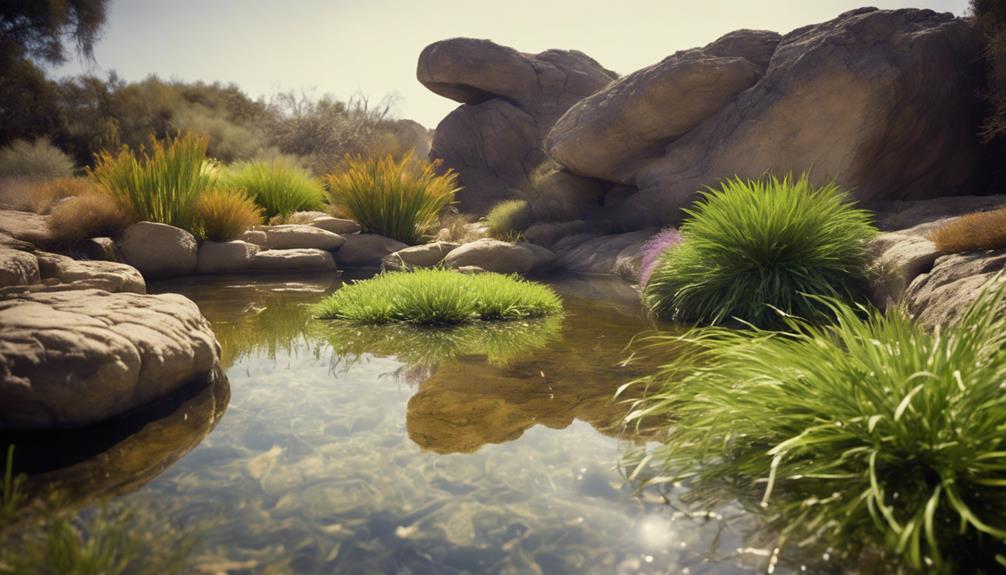
Mediterranean-zone plants, adapted to survive dry summers and rainy winters, prove ideal for gardens in California and other dry climates, where they'll thrive even during extended dry spells.
You can count on these drought-tolerant plants to perform well in areas with infrequent watering. For instance, succulents store excess water in their thick leaves, allowing them to survive for 10 days or more without water.
If you're looking for plants that can thrive in full sun areas, consider Lantana, Coneflower, and Yarrow.
These plants require minimal watering and can tolerate hot, dry conditions. Rockrose and Desert Willow are other great options that have evolved to survive in water-scarce conditions.
Aquatic Plants for Dry Climates
How can you create a thriving aquatic feature in dry climates where water scarcity is a concern? By incorporating drought-tolerant aquatic plants into your garden design, you can create a beautiful and sustainable water feature that requires minimal maintenance and care.
- Waterlily: A stunning plant that requires minimal watering and care, making it ideal for areas with infrequent rainfall or water restrictions.
- Cattail: A versatile plant that can thrive in shallow water and tolerate a wide range of water temperatures.
- Hornwort: A low-maintenance plant that can tolerate dry spells by going dormant, only to revive when water becomes available again.
- Rushes and Sedges: Plants that can thrive in shallow water and tolerate dry conditions, making them perfect for ponds or containers with limited water volume.
Plants That Love Dry Conditions
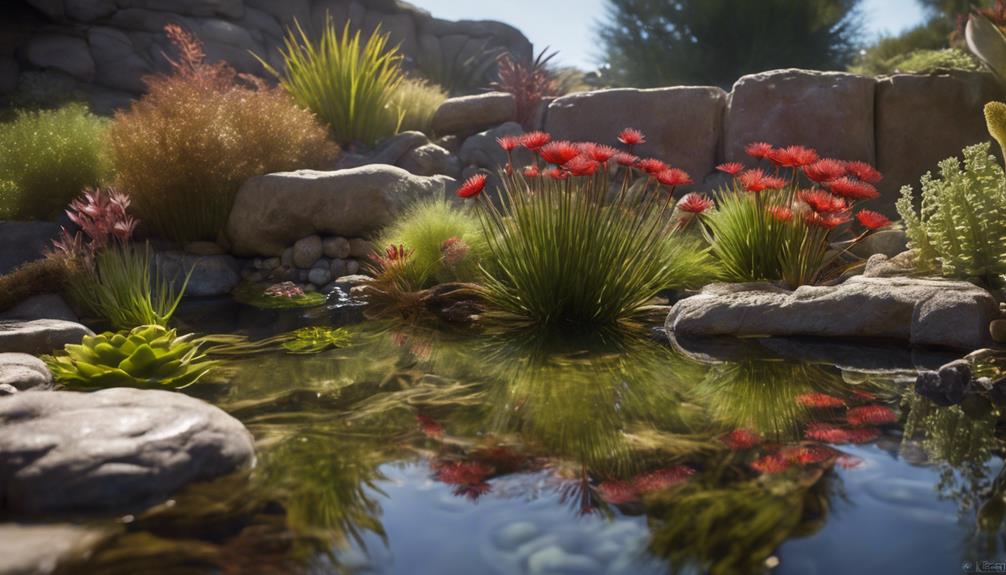
When designing a water-efficient garden in dry climates, you'll want to incorporate plants that have adapted to thrive in hot, arid conditions with minimal watering. These plants have evolved to survive in areas with low rainfall and high temperatures. Mediterranean-zone plants, such as succulents and drought-tolerant plants, are ideal for low-maintenance gardens in California and other dry climates.
Some examples of plants that love dry conditions include:
| Plant | Characteristics |
|---|---|
| Lantana | Thick, succulent leaves for water storage, thrives in full sun and well-drained soil |
| Yarrow | Requires minimal watering, perfect for hot and dry areas |
| Rockrose | Well-suited for full sun and minimal watering, ideal for areas around the home's foundation |
These plants have special features that enable them to survive in dry conditions, making them a great choice for gardeners in dry climates. By incorporating these plants into your garden, you can create a beautiful and sustainable outdoor space that requires minimal maintenance.
Low-Water Aquatic Plant Options
You can create a stunning and sustainable aquatic garden in dry climates by incorporating drought-tolerant aquatic plants that thrive in low-water conditions. By choosing the right plants, you'll not only conserve water but also create a unique and beautiful landscape.
Some of the best low-water aquatic plant options include:
- Water Hyacinth: A free-floating plant that can survive in low-water conditions and even help purify the water.
- Hornwort: A submerged plant that can tolerate a wide range of water conditions and is a low-maintenance option for ponds and aquariums.
- American Lotus: A flowering plant that can grow in shallow water and tolerate some drought, making it a suitable choice for gardens with variable water levels.
- Water Clover: A floating plant that can survive in low-water conditions and is also a natural food source for fish and other aquatic animals.
These drought-tolerant plants won't only thrive in your low-maintenance garden but also provide a unique and beautiful touch to your outdoor space. By incorporating them into your design, you'll be able to create a stunning and sustainable aquatic garden that requires minimal watering and care.
Drought-Resistant Aquatic Species
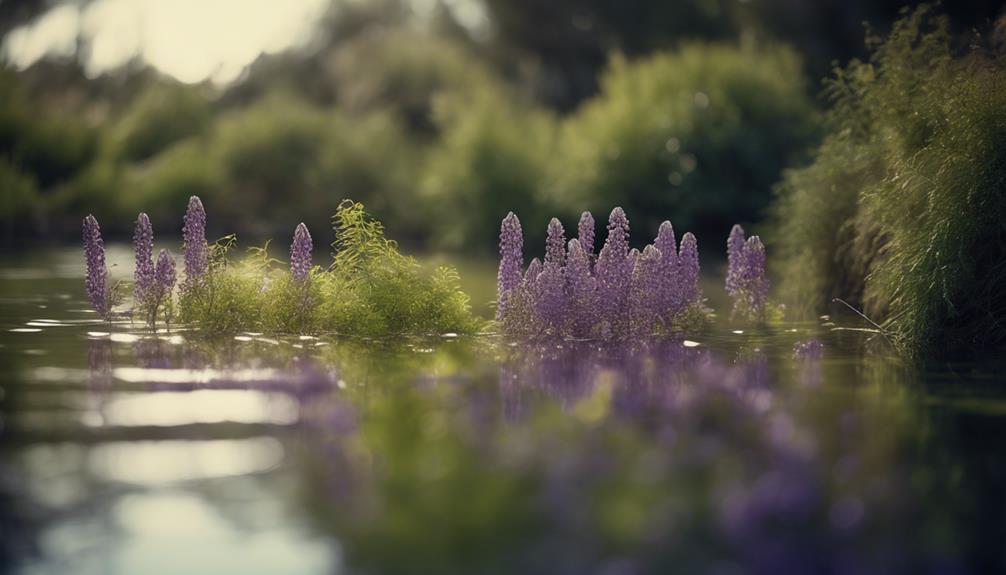
Among the diverse range of drought-resistant aquatic species, several plants stand out for their exceptional ability to thrive in water-scarce environments, including the Texas Star Hibiscus, Dwarf Papyrus, and Blue Flag Iris.
You'll appreciate the Texas Star Hibiscus's low-maintenance requirements, tolerating full sun to partial shade with minimal upkeep. The Dwarf Papyrus is another great option, requiring only 1-2 inches of water above the soil to survive.
If you're looking for a plant that not only tolerates drought but also helps maintain water quality, the Water Hyacinth is a great choice, although it may need regular trimming to prevent overgrowth.
For a pop of color, the Blue Flag Iris produces stunning blue flowers in the spring and can thrive in various water conditions. If you're concerned about pond bank stability, the Horsetail Rush is an excellent option, growing in a range of water conditions and providing erosion control.
These drought-tolerant aquatic plants are perfect for creating a beautiful, low-maintenance garden that can withstand dry spells. By incorporating these species into your garden, you'll enjoy a thriving aquatic ecosystem with minimal upkeep, even in water-scarce environments.
Frequently Asked Questions
What Garden Plants Do Not Need a Lot of Water?
You'll find that succulent options like Aloe Vera, storing excess water in their leaves, thrive in low-water conditions, making them perfect for your low-maintenance garden, requiring infrequent watering and minimal care.
What Is the Most Drought Tolerant Plant?
You're looking for the ultimate Succulent Champion, and you've come to the right place! Aloe Vera takes the crown, storing water in its leaves to survive extended periods with minimal watering, making it the most drought-tolerant plant of them all.
What Plant Doesn't Need Much Water?
You'll find that succulents, like Aloe Vera and Rockrose, don't need much water since they've developed a remarkable ability to store excess water in their thick leaves, stems, or roots, making them ultra-resilient in dry conditions.
What Plants Can Withstand a Lot of Water?
You're about to plunge into the world of aquatic wonders! As a Water Lover, you'll adore plants like Water Wisteria, Hornwort, and Vallisneria that thrive in waterlogged conditions, tolerating a deluge of H2O with ease, making them perfect for your low-maintenance oasis.
Conclusion
You've now got the tools to create a stunning, low-maintenance aquatic garden that can thrive even in dry conditions.
Take, for instance, the case of the San Diego Botanic Garden, which uses drought-tolerant plants like water lilies and cattails to conserve water while maintaining a lush, vibrant atmosphere.
By incorporating these water-wise plants into your design, you can enjoy a beautiful and resilient aquatic oasis, no matter the weather.

